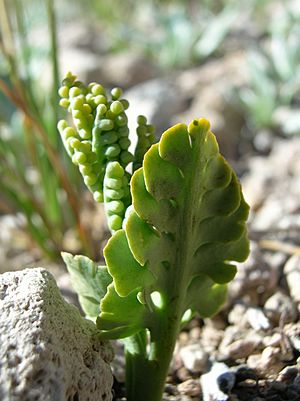Pumice moonwort facts for kids
Quick facts for kids Pumice moonwort |
|
|---|---|
 |
|
| Conservation status | |
| Scientific classification | |
| Genus: |
Botrychium
|
| Species: |
pumicola
|
The pumice moonwort, also known as Botrychium pumicola, is a very rare type of fern. It gets its name because it often grows in areas with pumice, a light, porous rock formed from volcanic eruptions.
Contents
Where the Pumice Moonwort Lives
This special fern is found only in a few places in the United States. It lives in the Modoc Plateau in northern California and near Crater Lake in southern Oregon. This means it is endemic to these areas.
For many years, people thought the pumice moonwort was gone from Mount Shasta in California. However, it was found again there in 2008! You can also find it in the Modoc National Forest.
Its Home: Pumice Habitats
The pumice moonwort loves to grow in dry, sandy or gravelly soil made of pumice. This soil doesn't have much humus (decayed plant matter). It needs places that stay a bit moist even into late spring.
These ferns live in open, sunny areas. They are often found in wide-open pumice fields or on gentle slopes. You might see them from high up in lodgepole pine forests to areas above the tree line. In winter, they are usually covered by deep snow.
The pumice moonwort can grow alongside other similar ferns. These include B. lanceolatum and B. simplex. It grows at high elevations, from about 5,900 to 8,850 feet above sea level.
What the Pumice Moonwort Looks Like
The pumice moonwort is a sturdy fern. It grows to be about 8 to 22 centimeters (3 to 9 inches) tall. Its leaves usually appear in the summer.
This fern is a mycorrhizal plant. This means it has a special partnership with fungi in the soil. The fungi help the fern get nutrients. The plant also has tiny structures called gemmae. These help the fern reproduce without needing spores. Some scientists think these gemmae might help the fern survive in dry places or after fires.
Plants in the Botrychium group are sometimes called 'grapeferns'. This is because their spore-producing parts look like tiny bunches of yellow-green grapes.
The fern's roots are thin and plentiful. It has an upright stem called a rhizome that grows underground. This rhizome is about 2 to 8 cm (1 to 3 inches) long.
Leaves and Spore Structures
The pumice moonwort usually has one or two upright leaves. These leaves can be 6 to 14 cm (2 to 5½ inches) long. The main stalk of the leaf grows mostly underground. This makes it look like the leaf comes right out of the ground.
The leaf blade is a dull, bluish-green color. It feels thick and leathery. The blade is shaped like a triangle and is divided into smaller parts. These parts overlap closely.
The part of the fern that produces spores is called the sporophore. It can be as long as or longer than the leafy part. It forms a very compact cluster of spore cases.
How Pumice Moonwort is Related to Other Plants
The pumice moonwort belongs to the adder's-tongue family (Ophioglossaceae). Some research suggests this family might be closely related to whisk ferns (Psilotaceae). These two groups of ferns seem to have developed very early in fern history. This might explain why they look so different from most other ferns.
For a while, some people thought the pumice moonwort was just a type of Botrychium simplex. While they are closely related, scientists have now decided that Botrychium pumicola is its own unique species. Botrychium montanum is also a close relative.
Protecting the Pumice Moonwort
Scientists don't know much about how this plant handles fires. However, pumice fields usually don't burn easily. It's likely this fern doesn't often face fires and might not survive them well.
Conservation Status and Threats
The pumice moonwort is considered a sensitive or vulnerable species by several groups:
- The United States Forest Service in the Pacific Southwest Region lists it as a Sensitive Species.
- The California Native Plant Society says it is "Fairly endangered in California."
- NatureServe gives it a Global Rank of G3, meaning it's vulnerable worldwide.
This rare fern faces several threats. People collecting ferns can harm its populations. Its home can also be damaged by outdoor activities, logging, and mining for pumice.
How to Identify It in Nature
The best time to look for the pumice moonwort is from July to September.
You can tell it apart from B. simplex because its leafy part is directly attached, and its spore-producing part has a very short stalk. The pumice moonwort also has a unique bluish-grey-green color. This is different from Botrychium lanceolatum, which is more yellow-green.


